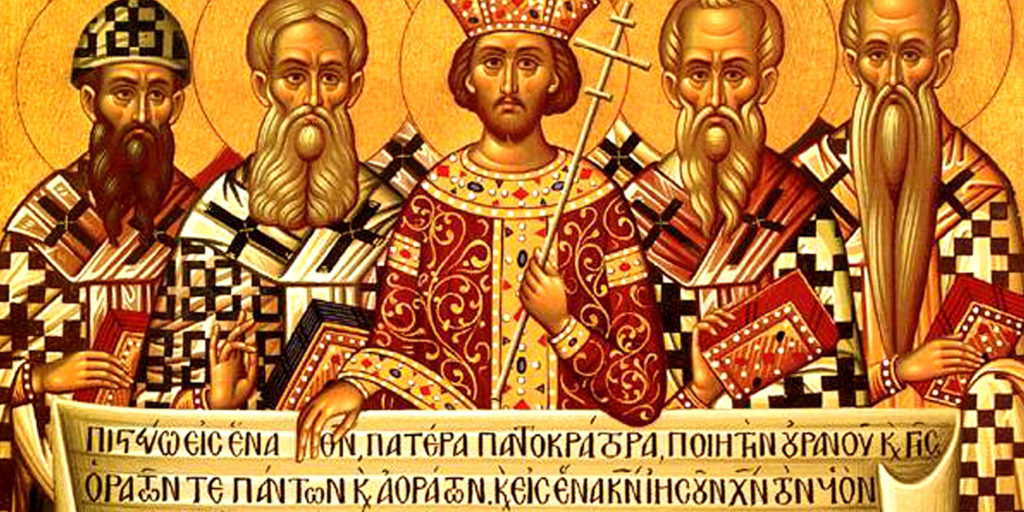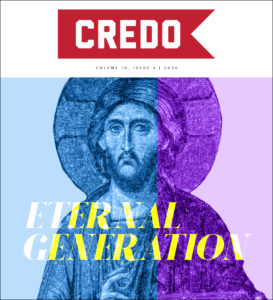
What Does it Mean to be “Pro-Nicene”?
T he new issue of Credo Magazine focuses on the eternal generation of the Son. The following is an excerpt from one of the issue’s featured articles by Shawn J. Wilhite. Wilhite is founder and editor of the Center for Ancient Christian Studies and Fides et Humilitas: The Journal of the Center for Ancient Christian Studies. He is Assistant Professor of Christian Studies at California Baptist University and has published The Didache: A Commentary. Currently, he is researching Pro-Nicene Theology and Cyril of Alexandria’s Trinitarianism.
he new issue of Credo Magazine focuses on the eternal generation of the Son. The following is an excerpt from one of the issue’s featured articles by Shawn J. Wilhite. Wilhite is founder and editor of the Center for Ancient Christian Studies and Fides et Humilitas: The Journal of the Center for Ancient Christian Studies. He is Assistant Professor of Christian Studies at California Baptist University and has published The Didache: A Commentary. Currently, he is researching Pro-Nicene Theology and Cyril of Alexandria’s Trinitarianism.
The fourth-century Christian era displays and contributes to some of the most essential principles of classical Trinitarian and Christological dogma and the formation of creedal confessions. Theologians and the Church may still use these features as starting points to communicate these doctrines. Johannes Quasten refers to the Nicene heritage up to Chalcedon as the “Golden Age” of Patristic thought. The Nicene and pro-Nicene heritage continued to inform and govern the general practice of theological formation and theological thought even up to the Chalcedon formula.
As we begin with the language of Nicaea and pro-Nicene theology, I mean to convey a few items. These early Christological and Trinitarian disputes extended well beyond a simple affirmation or denial of the divinity of the Son. The Synod of Nicaea and the aftermath of the Nicaea formula witnessed much dispute and clarity in the subsequent years. It seems that many theologians look at Nicaea as ushering in the victory of Christian theology. As Athanasius defeats Arius, according to the common trope, Nicaea becomes the Orthodox Athanasian victory. “Nicaea” means both the creedal formulation, the historical events surrounding 325 AD, and a theological culture that followed. Click To Tweet
However, the reception and retelling of Nicaea in the generations that follow are not so simple. The Creed brought about some confusion that required much clarity. As Arius and Athanasius appear to be front-runners in the initial formation of Nicaea, they are neither primary figures afterward. “Nicaea” means both the creedal formulation, the historical events surrounding 325 AD, and a theological culture that followed. And, pro-Nicene refers to a particular window that includes second and third generation defenders and advocates of the Nicene vision.
In 2004, Lewis Ayres defined pro-Nicene Trinitarianism in this way:
By ‘pro-Nicene’ I mean those theologies, appearing from the 360s to the 380s, consisting of a set of arguments about the nature of the Trinity and about the enterprise of Trinitarian theology, and forming the basis of Nicene Christian belief in the 380s.
Pro-Nicene Trinitarian theology assumed a few central theological items that would be generally representative. These three items are not the sole features, but they serve, at least, as the basis for a pro-Nicene heritage:
- Person and nature distinction
- Eternal generation of the Son
- Inseparable activity
Once more, Ayres recognizes that for something to be considered pro-Nicene, these three items ought to be present to identify as such.
While refraining from a reductionist set of arguments, I argue these three items can serve as a central base for pro-Nicene theology rather than a summary of pro-Nicene theology.
Person and Nature Distinction in Trinitarian Discourse
To describe God in nature is to describe God as one. To describe God in personhood is to describe God as three. Click To Tweet What language do early Christians use to describe the unity of essence and diversity of persons when describing the Triune God? Essence and personhood were described by a variety of words (οὐσία, ὑπόστασις, φύσις, natura, susbstantia, persona, and more). Early Christians forged a theological lexicon within the Nicene heritage. When reading one particular Father, they may use any one of these words in a different way than other figures in this era. So, great care rests upon the historian and theologian to work together to see the variety and often non-uniform manner early Christian theologians described God as one and God as three. There are standard and repeating statements among pro-Nicene figures that display this distinction in person. Often one will see a general expression that the Father is not the Son, the Son is not the Father, and the Spirit is neither Father nor Son.
Gregory of Nyssa’s brief letter to Eustathius, On the Holy Trinity, makes simple the unity of nature and distinction of personhood. For, that appears to be the very charge against Nyssen.
There are two brought forward together in the accusation against us; one that we divide the persons; the other, that we do not employ any of the names which belong to God in the plural number, but (as I said already) speak of the goodness as one, and of the power, and the Godhead, and all such attributes in the singular. With regard to the divine of the persons, those cannot well object who hold the doctrine of the diversity of substances in the divine nature. For it is not to be supposed that those who say that there are three substances do not also say that there are three persons. So this point only is called in question: that those attributes which are ascribed to the divine nature we employ in the singular.
These initial set of comments display the two different charges given to Nyssen. Charge one is a division of persons, and charge two is divine names are not employed in the plural. Gregory carefully notes that the titles that describe the divine nature do not appear in the singular. Thus, it is not three powers but one power. It is not three goodnesses but one goodness. Nyssen’s teaching is to uphold the persons co-equally sharing the one divine essence without division. These qualities unequivocally and wholly describe the single divine nature. That they are singular and display the single essence of God.
Augustine’s Sermon 52 (c. 410) concerns the story of Jesus’s baptism. As he comments on the descent of the Dove, Augustine notes at some length the inseparable Trinity and one God. To describe God in nature is to describe God as one. To describe God in personhood is to describe God as three.
In this single statement, the unity of God, the unity of three irreducible persons, and the inseparable activity form a fundamental doctrinal rule. According to Ayres, “the formulae we have seen in Sermon 52 are austere: they are an attempt to set out appropriate rules for an orthodox reading of Scripture and for orthodox talk of God.”
**Read the remainder of Shawn J. Wilhite’s article in the latest issue of Credo Magazine.

